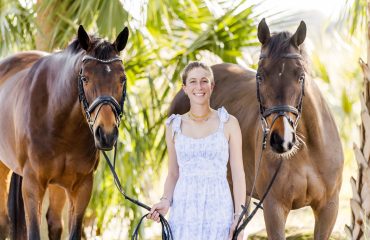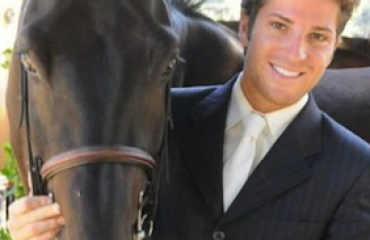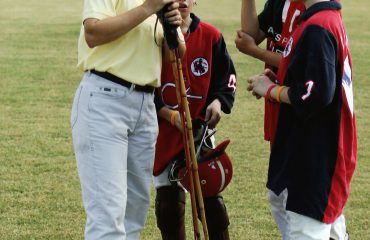By George Williams
When discussing the rider’s seat, it’s interesting to look at how the FEI addresses it in two perspectives from two very different tests. Unlike how we ask for it in our U.S. dressage tests, the stretching down is asked for in the sitting trot, not the rising trot, in these two tests. This may seem contrary to what we’re looking for when we ask a horse to stretch forward and down. However, when you think about the FEI Junior Rider Individual Test and the 5-Year-Old Young Horse Final Test and what they’re looking for in these instances, it makes perfect sense.
I always think of the FEI youth tests, whether it be Children, Pony, Junior or Young Rider, as rider tests. In other words, they test the correct development of the rider in their seat, use of aids and knowledge of movements. Likewise, the Young Horse tests look at the correct development including strengthening, acceptance of the seat and aids, and training of the horse. The common denominator in both tests is the emphasis on the rider’s independent seat and the horse’s acceptance of the seat. Both are extremely important to the development of a rider and of a dressage horse.
Much has been written on the importance of the rider developing an independent seat. According to our own U.S. Equestrian Federation Rule Book, “All the movements should be obtained with imperceptible aids and without apparent effort of the rider. The rider should be well-balanced, elastic, sitting deep in the center of the saddle, smoothly absorbing the movement of the horse with its loins and hips, supple thighs with the legs steady and stretched well down. All of these criteria enable the rider to follow the movements of the horse smoothly and freely.”
Later in the same rule, it says, “Only the rider who understands how to contract and relax its loin muscles at the right moment is able to control their horse correctly.” DR 117 sums up “The Position and Aids of the Rider” with, “The effectiveness of the rider’s aids determines the precise fulfillment of the required movements of the tests. There shall always be the impression of harmonious cooperation between horse and rider.”
“The Principles of Riding,” which refers to itself as “The Official Instruction Handbook of the German National Equestrian Federation,” states, “Only if he has a balanced, supple seat will the rider’s aids be correct. Only correctly, consciously applied aids result in the rider acquiring the correct ‘feel’ and enable him to act upon the horse predictably and constantly. Even experienced riders should never stop working on the principles of the correct seat.”
Their next book, “Advanced Techniques of Riding,” harps on the same theme: “In training the rider, the most important point to remember is that only a rider with a correct seat, relaxed, balanced seat is able to give effective aids. This is especially important for the difficult movements of advanced dressage.”
The movements in the FEI Junior test tell us very quickly if indeed the rider has developed a good position with a seat that is truly independent—one that is able to follow the horse and not interfere. Therefore, the rider is better able to influence the horse with all their aids in a more positive and harmonious manner. Developing an independent seat is crucial to the development of all riders and is something that we should be continually working on and refining all the time.
Catherine Dufour addressed this with a great exercise in the Masterclass she taught during the Devon CDIW in September. She used an exercise my mentor and teacher, Karl Mikolka, taught me. You hold on to a “bucking strap” attached to the D-rings by the pommel of the saddle with your hand. The other hand holds the reins. With the hand holding the strap, you pull/hold yourself steadily into the saddle. In a very short time, the horse will start to relax and swing through its back. The horse and rider in the Masterclass demonstrated the effectiveness of this exercise very quickly. As the horse’s back started to relax and swing, the stride improved as did the cadence and suppleness of the rider’s back.
This can also be done on a long rein traveling down a long side of an arena, and can be especially effective on young horses in developing a longer stride with greater freedom. What you learn through this exercise, and why it can be important to use the strap, is that a quiet seat that follows the motion on the horse can indeed improve the stride. You also learn how important it is that a horse learns to lift its back up into the rider’s seat, so that they carry the rider properly and can move freely under the rider. It goes without saying that a horse must trust the rider’s seat, meaning that the rider must be supple and well balanced, so the horse willingly and confidently lifts its back up to the rider’s seat. In my view, this is what is being tested when stretching forward and down in the sitting trot that is asked for in the FEI 5-Year-Old Test. Fritz Stecken in his book, “Training the Horse and Rider,” published in 1977, wrote, “Every horse can walk, trot and canter, but the horse must also carry the rider’s weight, and it is not accustomed to this in the beginning.” In other words, a horse must learn how to carry a rider—one of the fundamental goals of dressage training.
Call me old-fashioned, but I see learning to develop an independent seat that is able to influence the horse without interfering and the horse’s acceptance of the rider’s seat and willingness to lift its back to carry the rider as two important principles of dressage.
Photo:
Riders should never stop working on the principles of the correct seat at the trot.
Photo by Ruby Tevis













